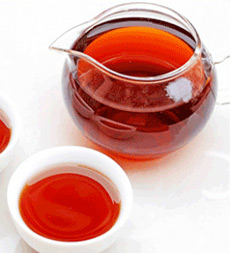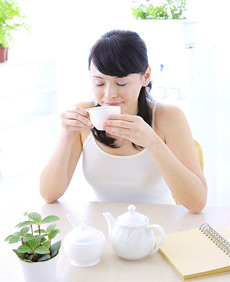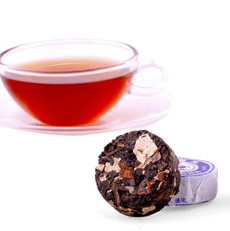|
|
Pu-erh Tea: A Great Way to Eliminate Free Radicals

Pu-erh tea, also spelled as Pu'er tea, is a variety of fermented dark
tea produced in Yunnan province,
China. Fermentation is a tea production style in which the tea leaves undergo
microbial fermentation and oxidation after they are dried and rolled. This
process is a Chinese specialty and produces tea known as Hei Cha , commonly
translated to dark, or black tea (this type of tea is completely different from
what in West is known as "black tea", which in China is called "red tea"). The
most famous variety of this category of tea is Pu-erh from Yunnan Province,
named after the trading post for dark tea during imperial China. Victoria
Beckham, one of the top models advocates Pu-erh tea.
Pu'er traditionally begins as a raw product known as "rough" Mao Cha and can
be sold in this form or pressed into a number of shapes and sold as "raw"
Sheng Cha. Both of these forms then undergo the complex process of gradual
fermentation and maturation with time. Pu-erh tea processing, although
straightforward, is complicated by the fact that the tea itself falls into
two distinct categories: the "raw" Sheng Cha and the "ripe" Shou Cha. All
types of pu-erh tea are created from máochá , a mostly un-oxidized green tea
processed from a "large leaf" variety of Camellia sinensis found in the
mountains of southern Yunnan.
Maocha can be sold directly to market as loose leaf tea, compressed to produce
"raw" Sheng Cha, naturally aged and matured for several year before being
compressed to also produce "raw" Sheng Cha or undergo Wo Dui ripening for
several months prior to being compressed to produce "ripe" Shou Cha.
Pu-erh vs. Green Tea
Un-aged and unprocessed, Maocha pu-erh is similar to green
tea.
Two subtle differences worth noting are that pu-erh is not produced from the
small leaf Chinese varietal but the broad leaf varietal mostly found in the
southern Chinese Provinces and India. The second, is that pu-erh leaves are
picked as one bud and 3-4 leaves whilst green tea is picked as one bud and 1-2
leaves. This means that older leaves contribute to the qualities of pu-erh tea.
Ripened or aged raw pu-erh has occasionally been mistakenly categorized as a
subcategory of black tea due to the dark red colour of its leaves and liquor.
However, pu-erh in both its ripened and aged forms has undergone secondary
oxidization and fermentation caused both by organisms growing in the tea and
free-radical oxidation, thus making it a unique type of tea. This divergence in
production style not only makes the flavour and texture of pu-erh tea different
but also results in a rather different chemical makeup to resulting brewed
liquor.
Health Benefits of Pu-Erh Tea
 Scientific studies report that consumption of pu'er tea leaves significantly
suppressed the expression of fatty acid synthase (FAS) in the livers of rats;
gain in body weight. Levels of triacylglycerol and total cholesterol were also
suppressed. The compositions of chemical components found to have been
responsible for these effects (catechins, caffeine, and theanine) varied
dramatically between pu-erh, black, oolong, and green teas. Scientific studies report that consumption of pu'er tea leaves significantly
suppressed the expression of fatty acid synthase (FAS) in the livers of rats;
gain in body weight. Levels of triacylglycerol and total cholesterol were also
suppressed. The compositions of chemical components found to have been
responsible for these effects (catechins, caffeine, and theanine) varied
dramatically between pu-erh, black, oolong, and green teas.
Specific mechanisms through which chemicals in pu'er tea inhibit the
biosynthesis of cholesterol in the laboratory have been suggested. In multiple
studies done in several countries, pu-erh tea has shown significant success in reducing
blood cholesterol.
One study done at the Wun-Shan Branch Tea Research and Extension Station in
Taipei, Taiwan compared the effects of green, black, oolong, and cooked/black
pu-erh teas on cholesterol in rats. The study showed the rats fed the cooked
pu-erh tea leaves had an increase of HDL-C (good cholesterol) and a decrease in
LDL-C (bad
cholesterol)
where the rats given the other teas had varying decreases in both types. This
means that with pu-erh tea you get the best of both worlds, an increase in the
cholesterol that you do want and a decrease of the cholesterol that you don't.
At China's Kunming Medical College, another study that consisted of 86 patients
with unusually high levels of blood cholesterol examined the differences in the
treatment of patients with Pu-erh tea verses conventional cholesterol
medication. 55 of the patients were given a regimented dose of pu-erh tea three
times a day; the other 31 were given a cholesterol lowering drug called PCIB in
doses of 1/2 a gram 3 times a day. At the end of a two month period, the
patients drinking the Pu-erh tea showed a 64.29% reduction in blood cholesterol
levels in comparison to 66.67% for the group taking PCIB. Cholesterol is not the
only benefit that pu-erh tea has to offer though. In 2006, a study found that it
has anti-aging and anti-cancerous properties by attacking free
radicals within
the body as well as actively protecting human fibroblast cells (connective
tissue) from damage and deterioration.
Pu'er tea has also been found to have antimutagenic
and antimicrobial properties in
vitro. (In vitro studies do not necessarily correlate to medicinal effects. An
article in Microbiologist, The magazine of the Society for Applied Microbiology,
in March 2008, Vol 9 No 1, p35, found that tea had many in vitro antimicrobial
properties against many organisms; for example English Breakfast tea at the
concentration used for drinking had significant antimicrobial effect on the
lethal anthrax bacillus (Bacillus anthracis) and many others, but this did not
make it a useful treatment for anthrax.)
Pu'er tea is widely believed in Chinese cultures to counteract the unpleasant effects
of heavy alcohol consumption.
In traditional Chinese medicine it is believed to invigorate the spleen and
inhibit "dampness." In the stomach, it is believed to reduce heat and "descends
qi".
Today we are constantly battling the toxicity of our everyday environment and
our potentially toxin laden food. Drinking pu-erh tea is a great way to eliminate
free radicals within
the body, lower your cholesterol and blood
pressure,
fight cancer,
and possibly look a little younger one cup at a time.
Shopping for Pu-erh Tea
 Pu-erh Tea is truly a wonder tonic but one must be careful when shopping for
this sought-after tea. There are many knock-offs and fake pu-erh teas out there,
and the older the tea, the more expensive it is. Sometimes tea cakes can sell
for thousands of dollars. Another concern is for the quality of the tea leaf
itself. Many of the cheaper teas can contain fluorine which, when ingested over
a period of time, can lead to fluorosis or fluoride poisoning. When you are
looking for a good pu-erh tea make sure that you are dealing with a reputable
tea house or seller, make sure that the tea is from the Yunnan province of
China, and make sure that the packaging states that the Tea was cultivated from
wild da ye or broad leaf tea trees. This may be a difficult task because most
pu-erh teas today are cultivated from multiple trees and from different areas.
In the end it's really the fermentation process that gives pu-erh its
distinctive taste and curative properties but if you're a tea purist, good luck
hunting down a true aged Pu-erh tea; it's difficult and you might just pay an
arm and a leg. Pu-erh Tea is truly a wonder tonic but one must be careful when shopping for
this sought-after tea. There are many knock-offs and fake pu-erh teas out there,
and the older the tea, the more expensive it is. Sometimes tea cakes can sell
for thousands of dollars. Another concern is for the quality of the tea leaf
itself. Many of the cheaper teas can contain fluorine which, when ingested over
a period of time, can lead to fluorosis or fluoride poisoning. When you are
looking for a good pu-erh tea make sure that you are dealing with a reputable
tea house or seller, make sure that the tea is from the Yunnan province of
China, and make sure that the packaging states that the Tea was cultivated from
wild da ye or broad leaf tea trees. This may be a difficult task because most
pu-erh teas today are cultivated from multiple trees and from different areas.
In the end it's really the fermentation process that gives pu-erh its
distinctive taste and curative properties but if you're a tea purist, good luck
hunting down a true aged Pu-erh tea; it's difficult and you might just pay an
arm and a leg.
Brief:
Pu-erh Tea has been used in traditional Chinese medicine for generations to
inhibit "internal dampness" (a term used in Chinese medicine to describe a build
up of internal energy due to the spleen`s inability to transform energy that it
receives from the stomach) and to invigorate the activity of the spleen and
stomach. Other traditional uses include the removal of toxins from the body,
curing dysentery, weight loss, improving eyesight, promoting blood circulation
and reviving those who have over indulged in alcohol.
-
Aids digestion and fat break down
-
Used in the treatment of arteriosclerosis, colds, bleeding and hepatitis
-
High level of Vitamin C which is soluble in water and can be rapidly
assimilated by the body.
Note:
Some pu-erh brick tea has been found to contain very high levels of fluorine,
because it is made from lesser quality older tea leaves and stems, which
accumulate fluorine. Its consumption has led to fluorosis (a form of fluoride
poisoning that affects the bones and teeth) in areas of high brick tea
consumption, such as Tibet.
|
|
|
|
|









